After a 0-1 start, how do the Irish match up to Nevada? Do the advanced stats hate Brian Van Gorder’s defense as much as most Irish fans currently do? And how many points can DeShone Kizer and the Notre Dame offense put up on Saturday?
If looking for additional information on the statistics and terms used here, great starting points are Football Studyhall’s Advanced Stats Glossary, Bill Connelly’s Five Factors, and Brian Fremeau’s FEI ratings.
Nevada Offense vs. Notre Dame Defense:
Note: I’m still using a lot of 2015 stats, since we have just one week of 2016 data (in Nevada’s case, against an FCS team. Next week much more early 2016 numbers will be phased in for ND, although Michigan State poses the same problem since they’ll only have played one game against an FCS opponent (Furman) this season.
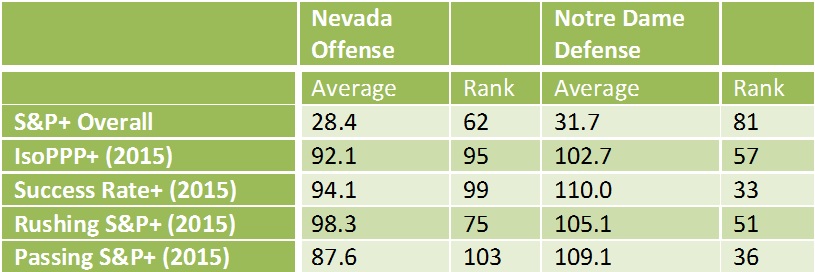
Nevada was woeful offensively in 2015, and it’s hard to read too much into their opener against Cal Poly. The offense returned nearly everyone – a 5th year QB in Tyler Stewart, a pretty explosive back in James Butler (6.4 YPC in 2015), their four leading receivers, and almost their entire two-deep on the offensive line.
Returning experience usually is a recipe for improvement right? Sure, but just how much progress depends on the quality of the returning players, and in the Wolfpack’s case, it’s questionable. The passing game struggled mightily last season, and even with incremental improvement they should be well below average nationally. Thankfully for the Irish secondary, none of the returning receivers remotely resemble John Burt and Jerrod Heard with their speed, with the top three receivers all under 8.1 yards/target.
While Butler is dangerous in the open field, and they add another talented back in Penn State transfer Akeel Lynch, the running attack was extremely inconsistent in 2015. As Bill Connelly examined in his season preview, Nevada was feast or famine – relying on breaking big runs, but struggling in power running situations and with lots of rushes stuffed for losses or minimal gains. The Wolfpack figure to be run-first, and will test Notre Dame with a variety of rushes from both backs and options for Stewart, who is a solid runner.
New coordinator Tim Cramsey has spent time learning under Chip Kelly, and worked with new Oregon QB Dakota Prukop last season at Montana State. The Wolfpack didn’t run plays at a fast pace against Cal Poly, but you can bet after watching Texas film they’ll probably give it a shot in South Bend. The Nevada offense’s ceiling is probably middling nationally, but with a running-threat at QB and the potential to go up-tempo, we’ll quickly learn how much Brian Van Gorder and the defense learned from the ugly opening game.
What should fans hope to (realistically) see from the defense in the home opener?
Stop the Run on 1st Down: While the long passes by Texas were painful, they were set up by the Longhorns controlling the line of scrimmage, especially on first down. Notre Dame knew Texas would go up-tempo and run-heavy, yet couldn’t stop them.
The Longhorns ran on 82% of first downs, and averaged 5.5 yards per carry on those rushes. Nevada figures to be similarly run-heavy, and while they likely don’t have the line or backs to be as efficient as Texas, they’ll definitely try! At the very least, they may be able to get their explosive backs a few opportunities in the open field.
If the Irish can put Nevada in 2nd and long situations, they’ll have a fighting chance at more disruptive plays – and learning before Michigan State if they’re better equipped to bring pressure or drop more players back in clear passing situations. Stopping the run on first down will lead to leverage wins and is directly related to the next key…
Force. Passing. Downs. For this Irish defense, this isn’t a “nice to have”, it’s an imperative. This falls into the “no duh” category a little bit – sure, it’s easier to stop opponents on passing downs! But check out this disparity – as bad as the defense was against Texas, they actually limited the Horns to just an 18.8% success rate on passing downs, compared to 56.5% on standard downs.
On standard downs Shane Buechele was 13 of 17 for 244 yards and a touchdown (14.4 YPA). On passing downs? 3-9 for 36 yards (4.0 YPA) and an interception.
I suspect for a team with lots of inexperience and true freshmen roaming the secondary, it’s even more important for Notre Dame than the average team to force passing downs to simplify their lives. On 3rd and 4, Devin Studstill has a ton to worry about – where to fill on the run, being wary of play-action, and a mobile QB. On 3rd and 9? Much simpler – play the pass, keep things short of the chains, and get off the field.
Will Notre Dame get a sack this year?
Like Texas, the Nevada defense was porous last season protecting Stewart on passing downs. According to ESPN Stats and Information, in Austin the Irish defense pressured the quarterback on just 3.7% of dropbacks – the worst for Notre Dame in six years and 2nd worst in the entire P5 for the first week.
I’ll be keeping an eye on the defensive line personnel in particular – will we see mostly four down linemen, or will the 3-3-5 make a return? Andrew Trumbetti struggled mightily during week one – will Jay Hayes be healthier and take a few snaps? What about the debut of Daelin Hayes, or more time for Jonathan Bonner, who made some nice plays in limited time last Sunday?
The Irish don’t need pressures and sacks in this game in order to win, but if they can’t effectively rush the passer against Nevada, it should influence how aggressively Notre Dame approaches Michigan State on defense.
Notre Dame Offense vs. Nevada Defense
There is blood in the water here, and a chance for redemption for Notre Dame’s offensive line, which underwhelmed against Texas. Nevada’s defense was bad across the board in 2015, and replaces its entire starting front seven from a year ago. Against a funky, triple-option based Cal Poly offense in the opener, the Wolfpack gave up 383 yards rushing!
The Wolfpack should fare a little better against the pass, where they return their starting corners and safeties, but it’ll be a tough task to help against the run and also slow down a red-hot DeShone Kizer.
Who steps up at receiver?
The prudent move on Saturday is to hold Torii Hunter Jr. out – even if cleared, the Irish shouldn’t need him until Michigan State. But in his absence, who will step up as pass catching targets?
Equanimeous St. Brown and C.J. Sanders both had great performances versus Texas that should give them confidence they can build upon moving forward. But with Hunter out, the offense stalled, managing a success rate of just 20% after he left the game compared to 50% with him in.
Corey Holmes, Miles Boykin, and Kevin Stepherson should all have opportunities to make the case for additional snaps moving forward in a competitive but inexperienced position group. We could have some freshmen sightings as well – keep an eye out for Javon McKinley and Chase Claypool.
Time for the offensive line to dominate: Harry Hiestand’s group fell a bit short of expectations against an athletic Texas front – there wasn’t a lot of room for Tarean Folston and Josh Adams to work with, especially down the stretch. At home, it’s time for the line – especially the new starters like Sam Mustipher and Colin McGovern – to push around a less experienced and less talented defensive front.
Predictions:
FEI: Notre Dame 38, Nevada 17
S&P+: Notre Dame 47, Nevada 24
MB: Notre Dame 48, Nevada 28
I think this game will play out a lot like UMass last year – the Irish offense moving the ball with ease, but the defense making some head-scratching mistakes that lead to a competitive game early. Notre Dame should pull away late, but I don’t trust the defensive discipline against a tricky running attack to hold up well enough to predict a cover.


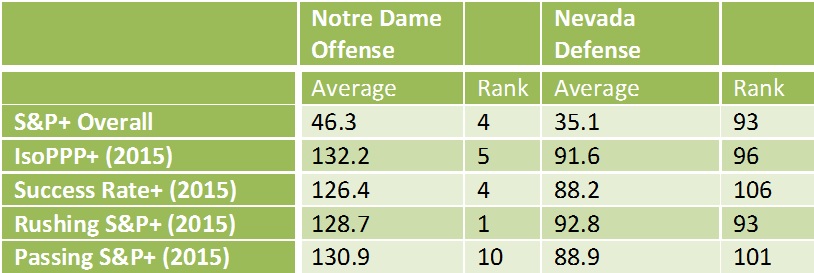
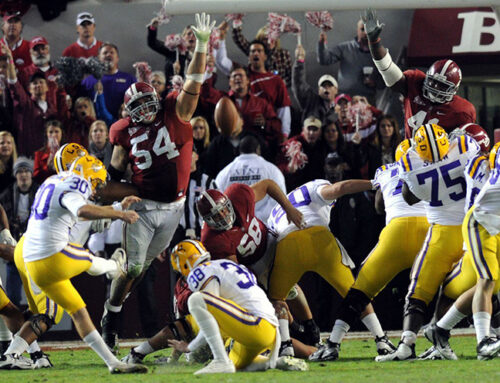
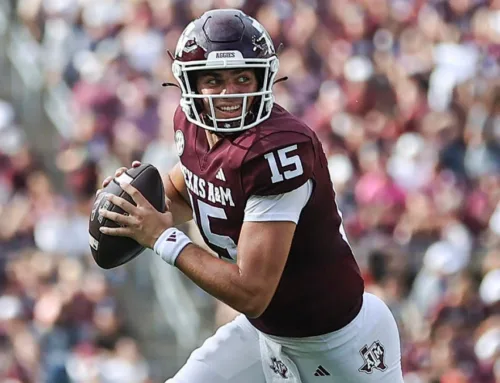
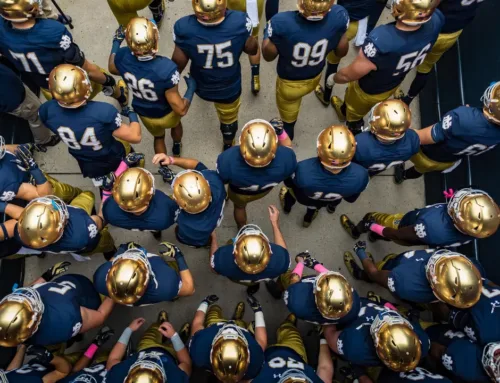
Man,
Just wow. And this may not even be the worst part of that game, defensively.
I’m sick of thinking this, so I’ll say it and I won’t say it again until after the Nevada game, but what an absolute joke VanGorder is. I’ve given him more than the benefit of the doubt and I hope he proves me wrong this year. I seriously doubt it.
It’s this one for me:
I’d be willing to bet that the 18% skews towards the end of the regulation and overtime, too, which would mean they spent the vast majority of the game running straight at us on first down and we couldn’t stop them. We’re beating a dead horse at this point, but that’s what made sticking with the 3-3-5 such a mind-blowingly bad idea. It was a bad idea to begin with, Texas identified the obvious weakness immediately, and then hit it over, and over, and over, and over, and over, and over, and… Well, you watched it too.
Anyway, looking forward to turning the page tomorrow. I’ve had enough of dissecting the Texas game.